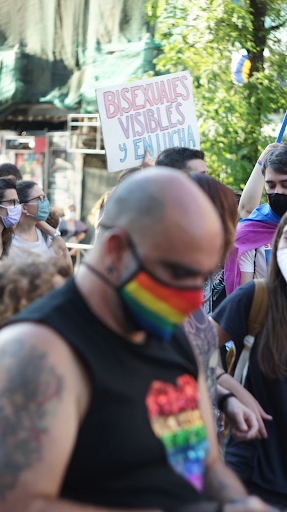morena (she/her) A polling survey conducted by the Williams Institute School of Law at UCLA finds 3.5% of adults [9 million] in the United States identify as lesbian, gay, or bisexual with over 1.8% of them identifying as bisexual. While this suggests over half of LGB Americans are bisexual, this group is often neglected both within and outside of its community. This phenomenon, called bisexual erasure, refers to the tendency to ignore, remove, or reject the presence of bisexuality in favor of sexualities that are attracted to a single gender; therefore those who engage in bisexual erasure prioritize their own sense of comfort despite the valid presence of bisexuality. Primarily, there are many reasons found throughout our society for the persistence of this issue both within the LGBT community and in the media. Sexuality is commonly misidentified as a binary choice between liking men or women, with reinforcements interspersed through the content and culture we consume daily. For instance, there are few media characters who openly identify themselves as bisexual, few news stories reporting on bisexual stories, and few resources available to address the disparities faced by this community. Additionally, this sexuality is often accused of simply being a phase or temporary identity in which people ultimately end up making a binary decision between being gay or straight over time. These instances of erasure are problematic as they deprive a large number of people the acceptance and representation necessary to come out as well as live a comfortable life with their identity being recognized. Specifically within many media representations of this group, bisexuality has been misrepresented to portray a temporary phase of identity in which the protagonist ends up making a binary decision at the end. About 67% of queer characters on television and 55% of queer characters in movies are gay men or lesbian women, despite bisexual people being estimated as the majority of the LGB community in the United States. This erasure in media impacts young bisexuals who have little representation in the media they are consuming while growing up, which could contribute to the lower rates of bisexual people who come out as adults. Continuing to explore the aspects of bisexual erasure, there are distinct gender stereotypes within our culture surrounding bisexuality which contribute to the removal of this sexuality. Men who are bisexual tend to be referred to as gay, and/or overly affectionate. Women who are bisexual are often referred to as attention seeking, and are likely to be fetishized. These stereotypes are reinforced both in the community and in media, effectively contributing to the perception of the bisexual community as well as the misinformation or erasure that persists within our society. The questioning of the legitimacy of bisexuality is not only found in the media, but also within the LGBT community itself. Since bisexuals are constantly reduced to the partners they are currently with, bisexuals are more likely to experience homophobia and accusations of appropriating LGBT spaces. The excuses for this treatment are attributed to being in “straight passing” relationships. To be straight passing must mean you have more privilege, right? While a relationship which appears heterosexual to outside observers might shield some in “straight passing” relationships from harassment or institutionalized discrimination, it comes with a cost. The perception of one's relationship as “straight” can cut off bisexual people from the queer community, leaving them increasingly isolated and without resources to address the homophobia they experience. Instances of this occur at pride parades throughout the month of June, in which “straight passing” couples could feel more isolated at the event because of this notion, despite outside observers not knowing if either of them are queer solely based on their appearances. This phenomena leads to more bisexual people avoiding coming out or discussing their sexual orientation openly as there is a feeling of “not being queer enough” reinforced, once again contributing to the erasure of this community. The reluctance to accept bisexuality could be in part due to the dichotomous black and white thinking in our society, in which a fluid sexuality like this one is viewed as a phase instead of a permanent identity. This conjecture addresses the failure to account for the “in between” space inhabited by this community as well as the ill attempt at trying to fit people into binary labels they simply do not fit into. Further, this stigma surrounding bisexuality impacts both mental and physical health of this community. Bisexuals tend to have greater rates of anxiety and depression than others in the LGBT community. Additionally, preventative care for bisexuals is lacking compared to other sexualities, which further contributes to the health disparities present. As the Gay & Lesbian Alliance Against Defamation organization explains, “Bisexual erasure plays a critical role in reducing the community's visibility and, in turn, reducing access to the resources and support opportunities bisexual people so desperately need.” Further statistics provided by the Human Rights Campaign states research has shown that 39% of bisexual men and 33% of bisexual women don't disclose their sexual orientation to any health care provider. Therefore, bisexual erasure effectively limits the visibility of this group, negatively impacting their mental and physical health. Clearly, accusations of wanting attention are nonsensical, as this community continues to experience intense disparities and oppression both within their own communities and outside of them. To fight bisexual erasure, the stigma surrounding this sexual orientation needs to end in order to promote bisexual visibility. Bisexual visibility is key in celebrating and encouraging the acceptance of this group, both within the community and within media representations. Visibility cannot end with simply providing more representation, but also providing an accurate representation that combats the stereotypes and assumptions imposed on the community. With more accurate bisexual representation in the media and within the LGBT community, there will be a more accepting and inclusive environment created for everyone to enjoy.
0 Comments
Leave a Reply. |
Search by typing & pressing enter

